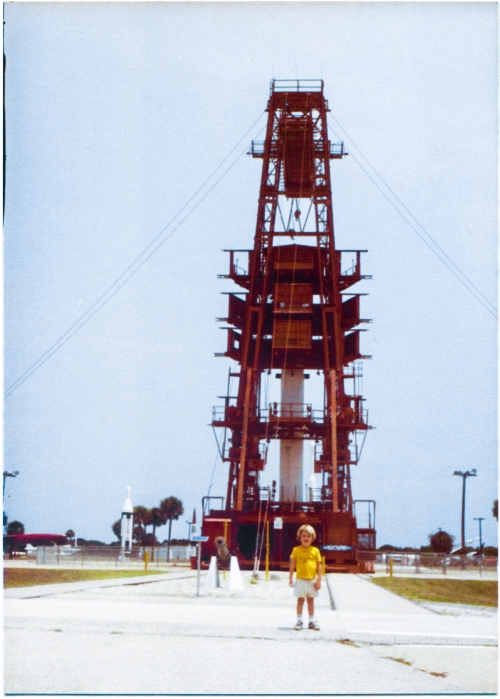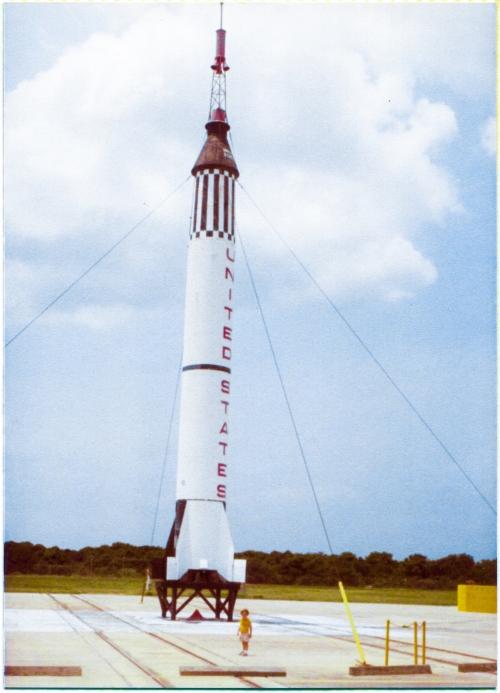The Construction of Space Shuttle Launch Complex 39-B
A very personal and technical written and photographic history, by James MacLaren.
Home Life: Page 3 - The Shimmering Heat Of Summer... Flowers Of Evil.
| Pad B Stories - Table of Contents |
...Flew
And now all is still. And no work has been done here in a very long time. And no work will ever be done here again, save that which preserves this plain expanse of concrete, baking, furnace-like, beneath a Florida Sky. And as you walk across it, your dad gains your attention and asks you once again to pause. And the camera clicks. And a mockingbird chirps and chips and twitters arrhythmically, faint and distant. And the breeze sags by inaudibly, and brings with it only more heat. And the heat bears down, silencing the land all around. Too hot even for the mosquitoes. And it is deeply silent. And the roar of the Mercury Redstone is no more to be heard.
Rockets, at their very foundation, in their innermost soul, are unimaginably evil machines.
Sometimes it's hard to imagine how things came to be the way they are.
Rockets fly, and nobody thinks very much about it.
It's just the way things are.
But once upon a time, rockets did not fly.
They blew themselves to hell on a regular basis, and flew poorly, or not at all, for the most part.
Incredible sums of money and energy were poured into the business of learning how to design, assemble, and launch rockets that would work, and work well.
Why?
People willingly threw the best years of their lives away, working sixty, eighty, and even hundred hour workweeks, driven like madmen grappling with a never-ending torrent of intractable problems, all in an effort to get the damn rockets flying, and flying right.
Why?
Wives and husbands languished at home, abandoned, alone, day after day, night after night.
Whole neighborhoods of children attempted to raise themselves in the absence of any actual parenting, and many children came to bad ends in the attempt.
Stress. Heart attacks. Alcoholism. Debauchery. Broken health, broken lives.
Why?
Fear.
Fear is why.
Fear is the Great Motivator, and fear was everywhere palpable back when the feverish work of bringing operational rockets on line was still in its infancy.
In the 1950's, there was one and only one justification for the Sisyphean heartbreak of trying to create working rockets, and that justification was thermonuclear warheads.
The warheads were the payload that justified the existence of the rocket. PAYload. As in that which pays for the rocket. Without the payload, money would never have been spent, work would never have been done, and time would never have been taken.
And without a payload, the rockets simply would never have flown, imperfectly or otherwise.
Inter-Continental Ballistic Missiles, ICBM's, would never have coalesced into flying amalgams of stainless steel and fire.
But vast military instrumentalities in two opposing Great Powers had thermonuclear contrivances. Both had payloads. Both were eager to develop the systems which could hurl devices capable of murdering tens of millions of people half way around the planet in less time than it takes to read these essays. And both were terrified that their Main Adversary might seize this ability for themselves first, thus holding an entire nation's population hostage for the dictation of terms, or, if terms weren't met, mass incineration on a scale that would make the ovens of Auschwitz look like child's play.
And I will say it again: Rockets, at their very foundation, in their innermost soul, are unimaginably evil machines.
The work of proper operational rocketry took its first toddler's steps in the 1940's with Nazis who sought only to kill mere hundreds of people simultaneously, using primitive chemical explosives. Things were stepped up vastly in scope and ambition during the 1950's when the development of payloads employing nuclear explosives began to justify the time and expense despite significant errors in aim-point accuracy. And the work goes on today, on a much more refined and terrorizing scale, with no end in sight.
The people and machines are in place and spreading, and the work never slackens, although we try hard not to think about it.
But from these flowers of evil an unexpected seed was produced that fell into fertile ground.
A seed that grew into something which bears no resemblance whatsoever to its parents.
And it was the Russians we can thank for this unexpected turn of events.
First in October of 1957, and again in April of 1961, the Russians, miraculously, found by mistake a way to turn the grim work of designing more efficient and more effective Systems of Murder into something entirely different. Something that served to siphon off some of the venomous energy of work on thermonuclear delivery systems and instead turn it into an amazing competition between the two largest power blocs the world had ever known up to that time.
We'll never know for sure, but it just might be that by starting the Space Race, the Russians accidentally saved all of our lives, and may even have kept truly insane individuals like General Curtis LeMay from killing us all and poisoning the entire planet whilst so doing.
The competition that was at the root of the Space Race of the 1960's was simplicity itself: Place people on top of an ICBM, launch it, and see if the rocket would explode or not, see if they might survive, see how far they could go, how long they could stay up there, what they might be able to do up there, and all for the greater glory of that nation which sent them on their harrowing way.
Along the way, a brash young leader upped the ante, and suddenly we found ourselves with the most absurd target possible, the goddamned Moon for christ's sake, squarely in the cross-hairs.
If you weren't around when it was all going down, then there will be no way to convey to you the sense of urgency, the sense of wonder, the sense of unified pulling together against a Dark Power, and the sense of accomplishment when it all went as planned.
Take my word for it, those were Amazing Days.
Kai stands amongst that which grew from those seeds, fallen into fertile ground. The parent stock from which those seeds were produced cannot reach him, cannot concern him. He is in the present and he is looking toward a future bright with hope, filled with promise.

